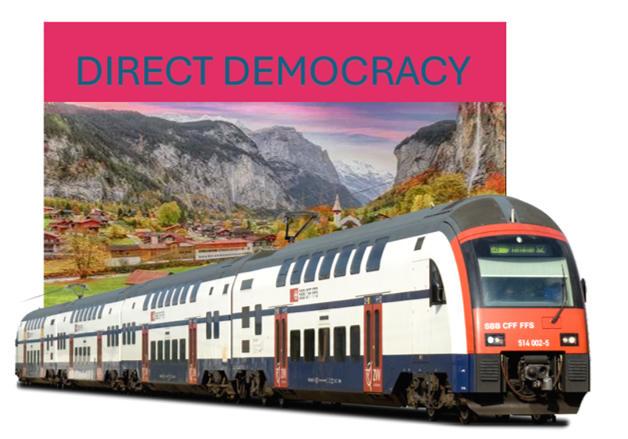Switzerland Chose Tracks Over Cuts & Prospered Everywhere
- 5thavenueartist
- Jul 28
- 4 min read
Switzerland’s Secret? It Never Abandoned Its Small Towns
In a world where small towns are too often left behind, Switzerland offers a quietly radical example of what happens when you choose connection over abandonment, foresight over short-term fixes, and community over centralization.
Take a map of Switzerland and look past the postcard-perfect peaks. Dotted between alpine ridges and lake shores are hundreds of small towns and villages—many with populations of only a few thousand. In most countries, these would be dismissed as economically marginal, too small to justify investment, not worth the rails, roads, or bandwidth. And yet, in Switzerland, these places hum with activity. They host the world’s most prestigious watchmakers, precision-tool firms, pharmaceutical laboratories, dairy producers, and machinery manufacturers. They ship globally. They hire locally. They thrive.
How?
What Happens When You Invest in Every Village: The Swiss Way
Because in Switzerland, the village is not a relic of the past. It’s a living unit of the future—deeply connected, both economically and physically, to the rest of the country and the world. It’s not just the trains, though the trains are emblematic. It’s the mindset.
Unlike other countries that opted for austerity and consolidation, Switzerland chose to maintain—and expand—its national rail network, ensuring that even its remotest mountain communities remain connected. Roads are maintained to high standards. Broadband stretches far beyond the cities. Public transport isn't just for cities; it's a lifeline woven into the very logic of national cohesion.
Contrast that with the United Kingdom in the 1960s, when the infamous Beeching cuts amputated 5,000 miles of railway and closed over 2,000 stations, mostly in rural areas. These decisions were framed as necessary cost-saving measures, but they initiated a cycle of decline. Once the trains were gone, jobs vanished, people moved away, local businesses collapsed, and vibrant towns turned into commuter husks or empty shells. Road transport couldn’t fill the gap. The economic arteries were severed.
In Switzerland, the arteries were strengthened instead.
The Long Game: How Switzerland’s Trains Built a Rural Powerhouse
This wasn’t accidental. It is the outcome of a political model designed to keep decisions close to those affected. The Swiss cantonal system gives power to regions and municipalities to decide how they use their land, shape their economies, and invest in people. Want to build a new rail stop near your factory? In Switzerland, the commune and canton can make that happen. Need zoning approval for an expansion? You’re not waiting on a distant capital’s bureaucracy. Want vocational training tailored to the machines you actually use? The education system adapts to your workforce needs—because it’s built into the same local logic.
And then there is the people’s voice—literally. Infrastructure decisions, tax regimes, transport subsidies, even massive tunnel construction projects like the Gotthard Base Tunnel or the Zimmerberg II—all are voted on. Not just nodded through by elite ministers in glass offices, but chosen by popular mandate. It’s not unusual for a farmer in Uri or a watchmaker in Neuchâtel to vote in favor of a rail link that won’t directly serve them, because they understand it contributes to a national ecosystem that includes them.
That is perhaps the most telling difference: in Switzerland, the alpine village with 800 residents isn’t an afterthought. It’s a strategic asset. It is seen, served, and supported.
Take Saint-Imier or Le Locle—watchmaking towns of under 15,000 people. They are globally important not in spite of their size but because of the specialized skill and heritage embedded there. These aren’t economies of scale; they’re economies of expertise. The roads and rails simply enable them to participate fully in a modern, globalized economy without abandoning their historic roots.
Tracks, Tunnels, and Local Power: The Quiet Genius of Switzerland’s Economy
You can’t achieve this without deep, long-term investment. And that’s where the philosophy really diverges. Where others treat railways and public transport as budgetary burdens, Switzerland treats them as strategic assets. The result? Expansion, not contraction. As part of STEP ES 2035 and Perspektive Bahn 2050, Switzerland is investing billions into tunnels, new lines, and faster service cadences—not to move people out of rural areas, but to keep them viable. Projects like the Grimsel Tunnel, the Herzstück Basel, and the new intercity connections aren’t just engineering feats—they are economic policies embedded in steel and rock.
And it works. Small towns in Emmental or Toggenburg ship their parts across the globe. Factories remain anchored in the places they were founded. Workers don’t have to choose between lifestyle and employment. Villages don’t hollow out. National GDP isn’t propped up by a few mega-hubs but distributed across a mosaic of productive places.
Even the cadence of trains reflects this philosophy: half-hourly or quarter-hourly departures on dozens of lines, reaching villages that many other nations would deem irrelevant. But Switzerland’s model isn’t about serving where the most people are—it’s about serving where value is created. The state doesn’t ask: “How many people live there?” It asks: “What happens there that matters?”
That’s the real lesson. When you see infrastructure not just as cost but as a foundation of economic inclusion—when your politics empower local decision-making, and when your citizens understand they are not merely taxpayers but shareholders in the nation—then villages don’t die. They lead.
In the end, Switzerland’s strategy is a quiet triumph of foresight over fragmentation. And the trains, punctual and persistent, are more than a symbol. They’re the steel thread that ties this whole decentralized, high-functioning miracle together.
While others paved over their past, Switzerland laid tracks to its future. How about in your country?




Comments